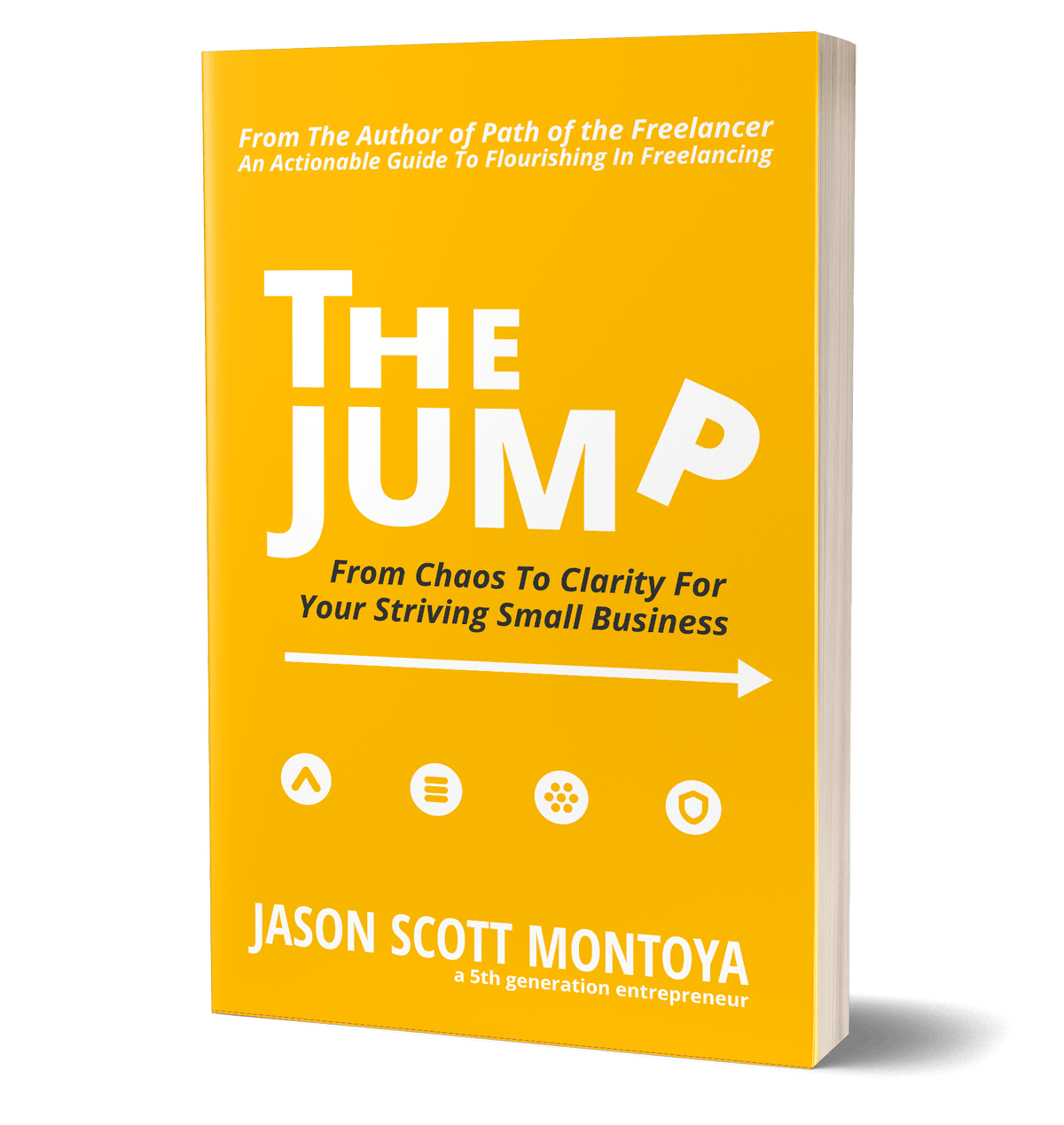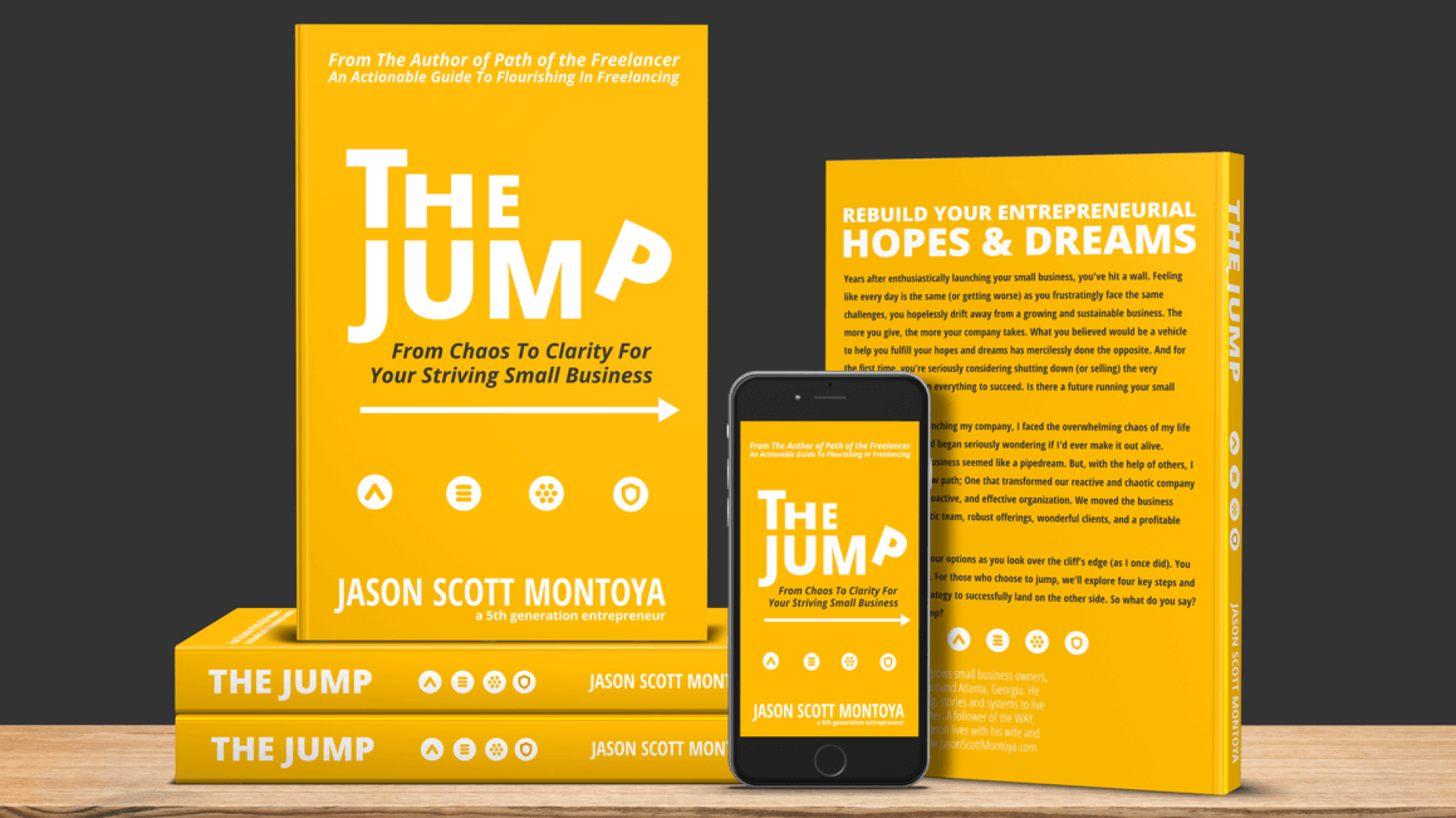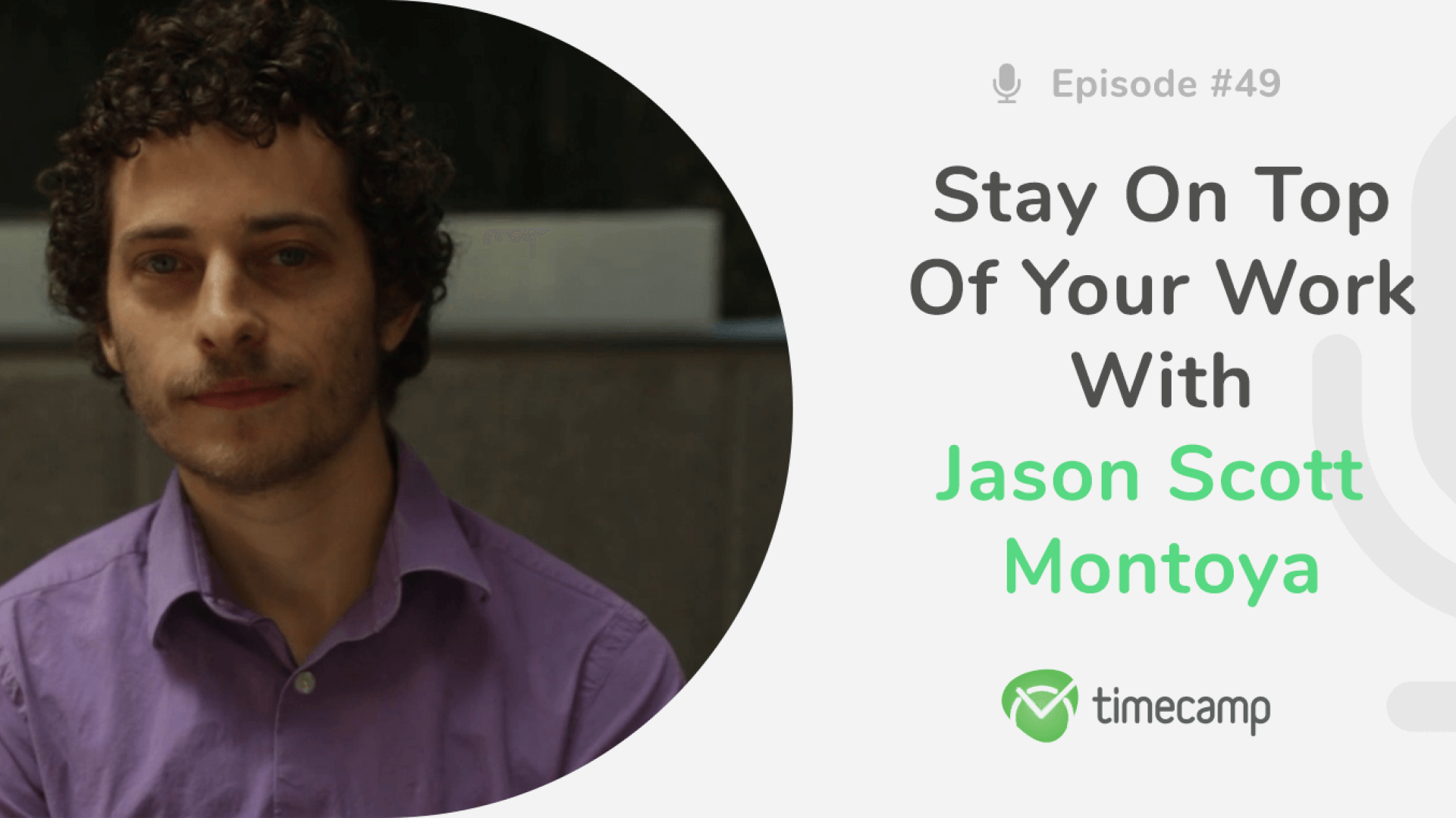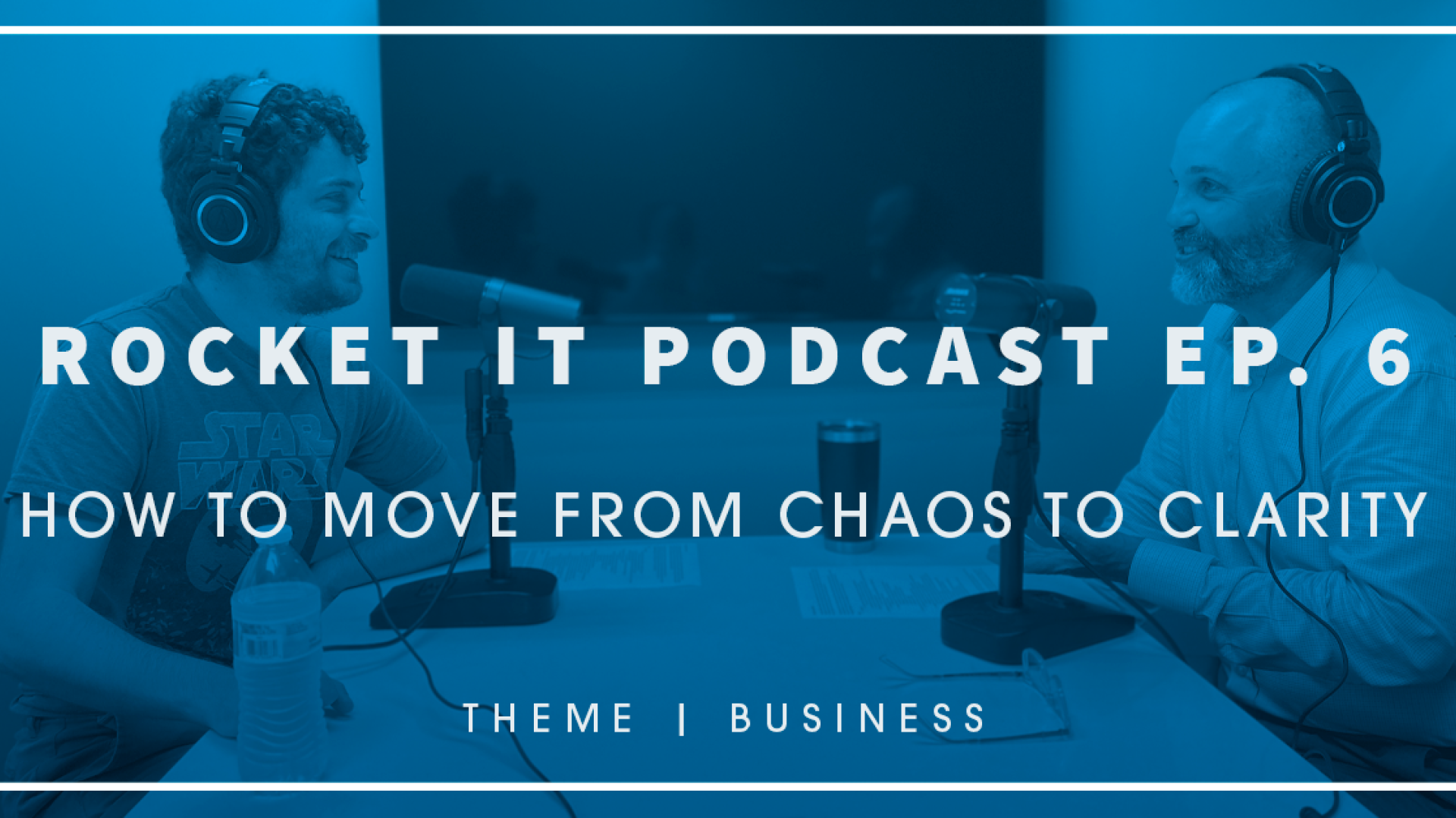
What Are The Five Stages Of Every Organization?
What if there were a way you could know and predict how your business would unfold? It’d be like the difference in driving across America in the modern-day versus attempting the same trip as the first explorers, Lewis and Clark. While it wouldn’t make it easy or prevent all issues, it would certainly provide you with a significant advantage.

In The Jump, we'll explore four key steps and a transformational strategy to successfully level up your small business. Is Your Small Business Stuck?
Shortly after shutting down my marketing company (of seven years) in 2014 and exploring my next career opportunities, I was talking with another marketing agency employee about their firm. As they described the company and answered my numerous detailed questions, a sense of deja vu came over me. I knew where they were on the journey of their business (because I had been there), and the stages that would soon follow.
It reminds me of frog DNA, from Jurassic Park, reintroduced in a business context by my friend James Karwisch.
“When a company, team, or individual goes about creating a strategy, they like to have as close to a full picture as possible of all the details to give themselves the best chance of heading in the right direction. But what about the times when you don’t have a full picture?” - Jim Karwisch
There are times when we don't have the full understanding, and we infuse our own experiences and perspectives to help us put together a picture of what's going on. That’s frog DNA.
Back to my meeting.
I infused this company’s story with the knowledge of my seven-year experience to provide a predictive model for the business journey.
While our company was around for less than a decade, we went through the race quickly, and this expedited pace acted as a catalyst for accelerating my personal development.
As I sat there listening to this person describe the season of their business, I could quickly point to the same moments in my journey, and our progression was strikingly similar.
The mistakes I made on the business journey, the ways I hurt people, and the success I had were all microcosms of what every leader faces. I quickly came to appreciate the opportunity to play in a small sandbox, because I was lucky to fail big in small contexts, unlike those who fail big in highly public ones.
Businesses of all types go through a predictable cycle. Some are larger, slower, and less adaptable, so their journey through the process takes years or decades. Other small companies with learning-oriented leaders are quicker to move through this process. Either way, there is a series of milestones these companies face during their lifetime, and it seems they can be pinpointed and predicted with a useful amount of accuracy.

IDEMA is the framework that best describes this journey. We’ll continue to explore it and its business application throughout the book.
When we (Beth Haun, Len Wikberg, and I) first developed IDEMA, we built a project management framework. However, we came to recognize that it also applied to departments and businesses as a whole. Here are the five stages born out of desperation to manage our projects by a team of people not inclined towards creating and using structure.
- Ideate - Capture Our Idea.
- Discover - Establish Intentions & Plan To Sustain.
- Execute - Start, Finish, & Prepare To Maintain.
- Maintain - Sustain Our Idea.
- Audit - Determine Our Assessed Idea's Fate.
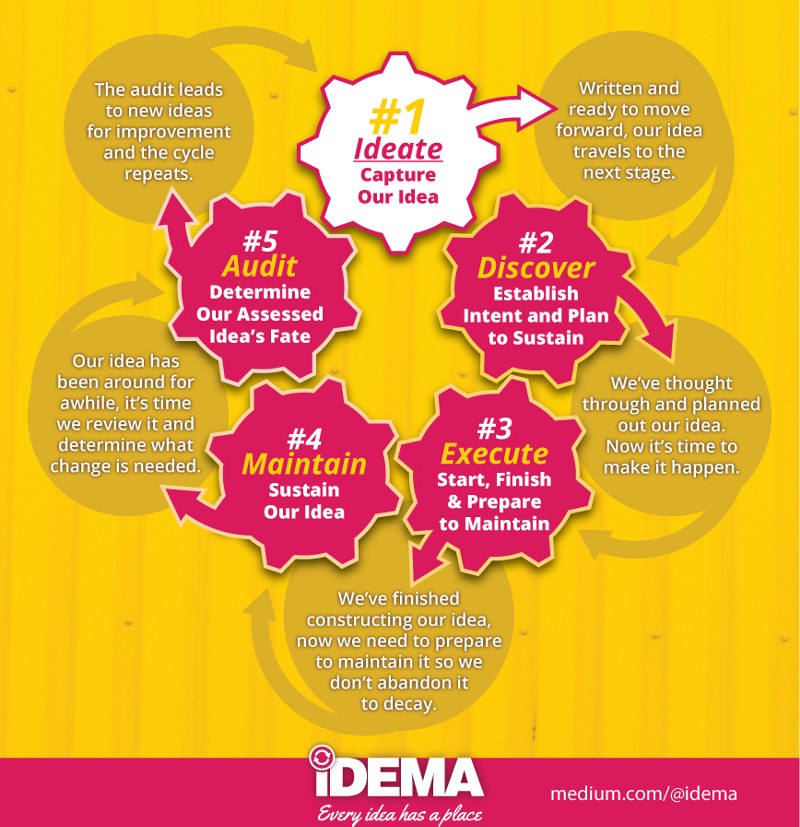
While these five stages start as a linear process, a company that lasts a lifetime, and even multiple generations, is one that learns to change this process from linear to cyclical.
Here's how these five areas of IDEMA intersect with companies.

#1 - The Ideate Stage - Capture Our Business Ideas
“Where does this invisible table of ideas live?”
My VP of Operations at Noodlehead Marketing was finally fed up with us tabling ideas. This tipping point and the subsequent and consistent form of accountability she imposed on us became part of her way to capture the many ideas we discussed but quickly forgot. Too many great ideas were lost, and she wanted to make sure they were collected and stored with care.
All companies start as an idea. Before we launch our business, we'll have an abundance of ideas we mostly forget. These ideas come and go until one day; we decide to start capturing them. Well, at least one.
This moment is when the idea goes from a fleeting thought to a captured concept. This captured concept is the point where we see the potential and completely ignore the realities that may prevent it from happening. It's also the point where we decide to take ownership of the idea and move it forward, at least to the next discovery step.
Imagine our business idea as a seed to a potentially giant oak tree in our yard. It can be planted to become something great, but if we only collect a jar of seeds, nothing will ever come from them. This lack of action is the downside of the Ideate stage, an abundance of ideas.
The real mission of this stage is to, metaphorically, capture these seeds (or at least the most important one) for planting. Moreover, when we do, we can explore them and our intentions further. It's this checkpoint that moves us from the first to the second stage. Discovery.
#2 - The Discover Stage - Establish Intentions & Plan To Sustain The Business
Now that we have a business idea and have made the decision to move it forward in the process, what now?
This crossroad moment is the time for research and exploration. What was the origin of the idea? What are the potential payoffs for our customers and us if our idea leads to success? And, what resources do we have to incubate and bring it to life?
These are just a few of the questions we'll explore in the Discover stage. For some, the discovery questions lead to a zealous jump into the next stage. For others, they'll end up asking so many questions that they get paralyzed preparing for the jump they'll never actually make.
The critical step in this stage is to take the idea through a deliberate process for determining the viability and feasibility of making this idea work as a business.
Some will have the opportunity for high risk while others will not. The better we plan, the more our intentions and reality will match. However well or poorly designed, we must make the jump from planning to execution.
For years, I wanted to launch my company. In retrospect, I was distracted by many other endeavors, some of which I wasn’t seeking out. They were opportunistic, chasing the results, but not a way to live out my intentions.
It wasn’t until my wife firmly pushed me to start the company that construction on Noodlehead Marketing began.

#3 The Execute Stage - Start, Finish & Prepare To Maintain The Business
We've got an idea, we've thought it out, and now we're going to bring it to life. This stage is where we take the red pill (from The Matrix) and move out of the dream world into the real one. But, like a rocket launching into space, this effort requires an abundance of energy to pull off successfully.
Out of excitement and passion, we start erecting our business by finding clients, hiring people, and accumulating resources to help us. In this stage, we can go too far and end up over-committing to more than we can realistically manage well. We say “yes” too often, and “no” becomes an elusive word.
As we attempt to juggle our company’s many conflicting intentions and realities, we end up not doing anything well.
We also find ourselves not sticking around long enough to finish what we start or allow the work to bear fruit. Our impatience leads to chronic abandonment. Often, people pay the price.
The roller coaster of ups and downs is most descriptive of this stage. We’re doing great, or we’re doing terrible. There is little in between.
Imagine what it was like to ride first class on the Titanic, eating rich food one moment, and then frantically looking for a lifeboat the moments after hitting the iceberg.
The key to businesses in the execute stage is discipline to finish what was started and not commit to more than we can steward well.
Once we form the habit of completion, the second key is planning to sustain during the finishing leg of each project. In a world of decay, everything we create requires maintenance. Without sustaining, any success we have will eventually fade away.
Once our team and we learn the importance of maintenance mastery, we’ll migrate our organization into the next stage.

#4 The Maintain Stage - Sustain The Business
Upon entrance to the maintenance stage, we've learned to finish, and we're planning to sustain the things we create.
We are pushing the flywheel in a perpetually forward motion. It’s like the human body’s primary systems (respiratory, circulatory, nervous, etc.) running like clockwork. As this continues, the consistency drives growth and benefit to the individual parts of the system as well as the whole.
If you’re not sustaining, you’re decaying.
Like the human body, a business can’t coast on its past success, or it (like our body) begins to slowly and unknowingly get unhealthy. Over time, our organization gets bloated. We keep gaining weight without losing pounds.
Bloated organizations cannot adjust or move as they need to survive & thrive. Eventually, they get caught in the bog, slow down, and fossilize (just like the dinosaurs). It's like standing in concrete. Once it's dried, it's almost impossible to move forward.
The key for organizations in this stage is to remember that we can't always rely on our past success, and anything we maintain needs to be regularly updated; otherwise, it becomes obsolete.
We also must inject a cadence of review and improvement. We need to shed those pounds and prevent ourselves from ever becoming bloated or fossilized in the first place!
Once we've embraced maintenance, we can now add the last ingredient of auditing, our fifth and final stage.
#5 The Audit Stage - Determine Our Assessed Business' Fate
Companies that make it to this stage are almost fully capable of operating in the full IDEMA circle (if they recognize it). They're reviewing projects, departments, and people to figure out how to make it all better. If we can't improve it or justify keeping it as is, it's time to end it.
Keep as-is, improve, or quit?
These are the questions to ask. There are no sacred cows, and everything must have a current justification. With a culture of auditing, we ensure we're as lean and straightforward as possible, while also remaining practical and relevant.
How do we create a real-time feedback loop on all things and people for optimal performance? That is the goal for companies in this stage.
Unfortunately, when we first enter this stage, our company is bloated, so it takes time to shed the fat and get it back to where it needs to be for effective operations.
When we arrive at this high level of performance, we must sustain these review systems to ensure we don't ever go back to building a bloated operation.
The danger in this stage is when we find ourselves auditing so much that we don’t provide enough time for the changes to take effect (impatience). We expect all feedback to lead to instant change. But, even sound and proven plans executed well often take an extended timeframe to produce positive results (patience).What Stage Is Your Organization Currently?
If you've owned and operated a company for an extended time, you'll recognize that these stages describe the life cycle of your operation. And, the one you’re in now (or want to arrive at) is likely the one that resonates most.
When we don't understand this cycle, we traverse through it over and over, feeling like we're living out the movie Groundhog Day with Bill Murray. Every day starts over, and we experience the same things for what seems like forever.
But, when we see and embrace this system, we can proactively engage in it to manage the weaknesses and leverage the strengths.
As you explore the jump in detail, knowing where in the journey your company currently resides will illuminate insights on how best you can make that upcoming leap and move your business forward.

Photo by Annie Spratt, Lili Popper, Shaun Holloway, Alexandru Tudorache, Sai Kiran Anagani, Aaron Burden, Galina, & Johannes Plenio on Unsplash
In The Jump, we'll explore four key steps and a transformational strategy to successfully level up your small business. Is Your Small Business Stuck?
